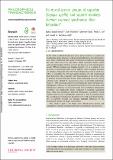Files in this item
Do mixed-species groups of capuchin (Sapajus apella) and squirrel monkeys (Saimiri sciureus) synchronize their behaviour?
Item metadata
| dc.contributor.author | Daoudi-Simison, Sophia | |
| dc.contributor.author | O'Sullivan, Eoin Patrick | |
| dc.contributor.author | Moat, Genevieve | |
| dc.contributor.author | Lee, Phyllis C. | |
| dc.contributor.author | Buchanan-Smith, Hannah M. | |
| dc.date.accessioned | 2023-04-17T14:30:13Z | |
| dc.date.available | 2023-04-17T14:30:13Z | |
| dc.date.issued | 2023-06-05 | |
| dc.identifier | 284141994 | |
| dc.identifier | 9f993a9d-4089-4c46-8a25-25262673c82c | |
| dc.identifier | 85152622020 | |
| dc.identifier.citation | Daoudi-Simison , S , O'Sullivan , E P , Moat , G , Lee , P C & Buchanan-Smith , H M 2023 , ' Do mixed-species groups of capuchin ( Sapajus apella ) and squirrel monkeys ( Saimiri sciureus ) synchronize their behaviour? ' , Philosophical Transactions of the Royal Society B: Biological Sciences , vol. 378 , no. 1878 . https://doi.org/10.1098/rstb.2022.0111 | en |
| dc.identifier.issn | 0962-8436 | |
| dc.identifier.other | ORCID: /0000-0001-9380-1648/work/133736895 | |
| dc.identifier.uri | https://hdl.handle.net/10023/27413 | |
| dc.description | Funding: Edinburgh Zoo's Living Links Research Facility is core supported by the RZSS (Registered charity number: SC004064) through funding generated by its visitors, members and supporters, and by the University of St Andrews (Registered charity number: SC013532) who core supports the maintenance and management costs of the research facility. | en |
| dc.description.abstract | In the wild, coordinated behaviour across group members is essential for maintaining spatial coherence, with potential implications for individual fitness. Such coordination often leads to behavioural synchrony (performing the same behaviour at the same time). Tufted capuchins (Sapajus apella) and squirrel monkeys (Saimiri sciureus) are known to form mixed-species groups (MSGs), travelling and foraging together. Yet, it is unclear if it is necessary to synchronize behaviours in captivity when ecological pressures are minimal compared to the wild. We investigated the extent to which two MSGs of capuchins (N = 35) and squirrel monkeys (N = 26) synchronized their behaviour with conspecifics and heterospecifics at the Living Links to Human Evolution Research Centre, RZSS, Edinburgh Zoo, UK. Group activities were sampled by instantaneous scans of all visible individuals. Scans (n = 180) were analysed for five most frequently observed behaviours. Intraspecies synchrony was calculated using Simpson's Diversity Index, and interspecies synchrony was measured using cross-correlations. Intraspecific synchrony was significantly greater compared to randomly aggregated data, while cross-correlations indicated interspecific asynchrony. Living together did not lead to interspecific synchrony as may be expected given the coordination and behaviour described in the wild, and shared husbandry in captivity. Overall, our findings highlight differences in the behavioural structure of single- versus MSGs. | |
| dc.format.extent | 8 | |
| dc.format.extent | 797621 | |
| dc.language.iso | eng | |
| dc.relation.ispartof | Philosophical Transactions of the Royal Society B: Biological Sciences | en |
| dc.subject | Capuchin | en |
| dc.subject | Squirrel monkey | en |
| dc.subject | Mixed-species group | en |
| dc.subject | Behaviour | en |
| dc.subject | Synchrony | en |
| dc.subject | QL Zoology | en |
| dc.subject | NDAS | en |
| dc.subject | MCC | en |
| dc.subject.lcc | QL | en |
| dc.title | Do mixed-species groups of capuchin (Sapajus apella) and squirrel monkeys (Saimiri sciureus) synchronize their behaviour? | en |
| dc.type | Journal article | en |
| dc.contributor.institution | University of St Andrews. School of Psychology and Neuroscience | en |
| dc.identifier.doi | https://doi.org/10.1098/rstb.2022.0111 | |
| dc.description.status | Peer reviewed | en |
This item appears in the following Collection(s)
Items in the St Andrews Research Repository are protected by copyright, with all rights reserved, unless otherwise indicated.

